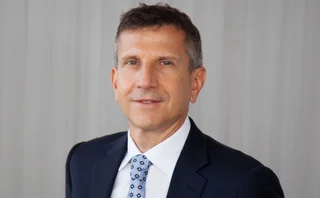
Derivatives House of the Year: JP Morgan

JP Morgan is a colossus in the global commodity derivatives market. Amid tougher bank capital requirements, tighter rules on over-the-counter derivatives and a decrease of hedging activity in some corners of the market, the bank continues to make rivals jealous.
In an exclusive interview with Energy Risk, Blythe Masters, New York-based head of global commodities, says it is still possible for JP Morgan to be a bank and maintain a sustainable business as a dealer of commodity derivatives. That comes despite a withdrawal of other banks, which have retreated from what were once core markets, such as US power and natural gas.
In addition to an energy franchise that encompasses oil, power, gas, coal and carbon emissions, the bank has a formidable offering across base and precious metals, soft commodities and agricultural products. It also enjoys wide geographical reach – over the past 18 months, the bank’s business has included executing physical hedges on coal, power and emissions for utilities in Germany, entering into financing and off-take arrangements for aluminium smelters in China and entering into off-take agreements with coal miners in Indonesia.
Of particular note was a long-term natural gas hedge struck for Houston-based Cheniere Energy, which hopes to become the first firm to export liquefied natural gas (LNG) from the contiguous US by the end of 2015. In July 2012, JP Morgan was among a syndicate of banks that helped the firm raise financing for the building of a new liquefaction plant at its Sabine Pass terminal in Louisiana, acting as joint lead arranger and co-bookrunner on a $3.6 billion senior credit facility. But the bank also brought something else to the table – a large and complex hedge for the gas required by the terminal for export.
The idea behind the trade was straightforward. Cheniere needed financing and had already entered into 20-year agreements to supply UK-based BG Group and Barcelona-based Gas Natural with 7.5 million tonnes of gas per annum. Were a significant proportion of that natural gas hedged in advance, JP Morgan’s team felt the firm could secure a better rate on its financing. As a result, the bank structured a physical natural gas supply deal covering about 50% of the gas required for Cheniere’s first two liquefaction trains at Sabine Pass. The deal, which was executed on a forward-starting basis with a tenor of five years, includes flexibility around the quantity of gas to be delivered at six different delivery locations in an effort to optimise the hedge. By structuring and integrating the trade into Cheniere’s existing arrangements with creditors, JP Morgan strengthened Cheniere’s commercial proposition and its ability to attain a cost-effective financing.
Companies that have invested in having a really broad client franchise are better able to spread [their] costs
As with other banks, regulation remains a constant focus at JP Morgan. In addition to her commodities role, Masters also leads regulatory affairs for JP Morgan’s corporate and investment bank. In the US, the Dodd-Frank Act has proven a major challenge for commodity derivatives end-users over the past 18 months – and during that time, JP Morgan has worked hard to help its clients comply with the rules. That meant holding frequent conference calls with clients, with participation from senior staff including Masters, as well as top salespeople and senior lawyers. JP Morgan also chairs a commodity industry working group that shares knowledge between dealers on the distinct challenges facing commodity derivatives businesses attempting to cope with Dodd-Frank.
Improvements to risk systems and back-office infrastructure are another priority for market participants – and the firm has been busy in this area too. During the past two years, the bank’s commodities unit has been consolidating a mosaic of risk systems inherited from predecessor firms, including Bear Stearns and RBS Sempra, moving onto a single risk management platform known as Athena. The last products due to move onto the system are base metals, North American power and natural gas by the end of 2013.
Not all the recent developments have been positive. On May 8, the bank revealed in a quarterly filing that it had received notice of a possible enforcement action against it from the US Federal Energy Regulatory Commission (Ferc). It comes after JP Morgan was stripped of its market-based rate authority by Ferc, due to allegedly misleading statements it made to the regulator in connection with an investigation of possible market manipulation. Masters would not comment on the matter for the interview below, although JP Morgan has denied it intended to mislead the agency.
Q. What are the biggest achievements you’ve enjoyed as a business during the past year?
Blythe Masters: Probably the thing that we’re happiest about is that we have been building, since as long ago as 2007, a client-orientated business that had the client base of JP Morgan in mind. We knew the environment was changing, obviously as a function of financial regulatory reform in all of its different forms, and we spent a lot of time seeking to get comfortable. But as a strategic matter, notwithstanding all of that change, we thought it really made sense to have a commodities business within a bank – and what this year proved to us was that that was true in practice. The way in which that manifests itself was that we transacted a number of large and important client transactions that could not have been done but for the broader franchise at JP Morgan, and could not have been done but for the very significant investment in expanding our commodities platform along the direction of both physical and financial capabilities – and really broad capabilities, rather than narrow or niche things.
We always knew we would be able to do great derivative transactions for a client because we’re a derivatives expert, but to be able to combine that with financing and asset-based lending, capital markets access, mergers and acquisitions and advice, physical supplies, physical off-takes – those sorts of things really are a unique package and that’s what paid off for us this last year. And that was happening in the context of a market environment where the actual wallet, meaning the total revenue available to the industry, was declining, largely as a function of the economic environment. What we essentially saw was an increase in market share as the market shrank and certain of our competitors, which hadn’t been able to achieve critical mass and scale, were forced to pull back.
Q. It’s a very interesting point you make about trying to compete in commodities as a bank. You obviously believe it’s still possible to compete as a bank in this market, but would you say it’s become harder?
A. I would say it’s different, in the sense that prior to the financial regulatory changes that have occurred in recent years, there was an opportunity for a bank to engage in commodity markets from a proprietary point of view and to mix that proprietary activity with client activity as a function of its discretion. That obviously is not an option any longer – and the question is whether or not the client-driven franchise is a sustainable business model. We believe strongly that it is, and that’s why we built the business.
There’s no doubt the costs associated with running a client franchise are higher than the costs associated with a more proprietary-heavy business model, and those costs are only increasing because of the effect of Dodd-Frank and the compliance requirements, increasing capital requirements and margin requirements and so forth. But it turns out that our customer needs aren’t diminishing at all – it’s still just as important for a client to manage their risks in this space, to get access to capital in this space, to deploy capital in order to develop their means of production and so on. They are happy to absorb some of those increased costs, and it turns out that the companies that have invested the most in having a really broad client franchise are better able to spread those costs over a larger volume of business and be more competitive than those that cannot.
This is why certain competitors have pulled out of the business. It’s not really because their clients didn’t need them there – actually their clients, by and large, have been hurt by the withdrawal of our competitors, because it leaves them with less choice. But the reason that firms like ours are able to survive and can prosecute a successful business model is definitely because we’re able to spread those costs over an adequate quantity of business activity.
Q. Basel 2.5 and Basel III have changed the risk/reward equation for many banks in commodity derivatives. Have they had a big impact on your business as well? Are there certain transactions that you might not get involved in as readily now as you would have in the past?
A. The picture is evolving and obviously Basel III is in the process of being implemented. Basel 2.5 and Basel II are in the past now, so we can see the effects. The general trend is that capital requirements for all banks have increased very significantly associated with most activities that we do with clients, including derivatives, but it’s not limited to that. It’s fair to say that it was broadly accepted – and certainly JP Morgan would not argue against it – that capital levels needed to increase in the aftermath of the financial crisis. As a broad matter, we as an institution have been supportive of that and we have repositioned our firm in order to achieve stronger capital ratios. We’ve done that ahead of the minimum requirements that Basel III will ultimately impose, because it needed to be done for risk management and firm-wide or enterprise risk management reasons – not just because of the rules that were coming.
Having said that, there are areas of the rules where we feel the calibration of the requirements relative to the risks themselves has got out of sync. For example, in the implementation of what is known as market risk in credit valuation adjustment (CVA), we and many others feel the approach being taken under Basel III is miscalibrated and vastly overstates the risk, and therefore requires excessive capital requirements, which ultimately will translate into it being much more expensive than it should be for our customers to do this type of business. As a reaction to that, the European Union has recently exempted its banks from being required to capitalise for that part of CVA in the Capital Requirements Directive 4 (CRD 4) – with the result that we have an unlevel playing field. That is not good for our clients either, because Asian banks and US banks will be forced to charge more for the same derivatives transactions as their European counterparts if this is left unaddressed. Along with many other institutions, we have been active in pointing out that the root cause of this problem is not the CRD 4 exemption per se, it’s the fact the underlying CVA capital requirement is miscalibrated in the first place. That should be fixed at the Basel level, in order to make sure that customers don’t have their choices even further restricted than they are already.
Q. When you talk about discriminating against certain transactions, I assume you’re talking about longer-dated, uncollateralised trades?
A. Yes, the less collateral and the longer-dated the trade, the bigger the CVA is. This is important for corporate clients, end-users and hedgers – those are the types of client that mind about this sort of thing.
Q. Dodd-Frank has continued to pose major challenges to energy market participants this year. How much of your time is taken up by working through those issues, both internally, and externally with your clients?
A. A lot... I couldn’t give you a percentage, but it’s certainly a significant amount of focus. Our main focus is on implementation and doing it in a fashion that minimises the adverse impact for clients, which is not a trivial thing to focus on. Earlier on, we were just really trying to position ourselves so that we understood what was going to happen. Then we had to think about how we made the necessary technology and infrastructure investment and whether our business model was still viable. So this is a continuous work in progress. There are many aspects of Dodd-Frank that have not yet been finalised, so we don’t even really understand what the final picture will look like. We also have a responsibility to make sure that policy-makers have access to information so that they can understand the consequences of their decisions. We don’t necessarily always agree with each other, but we do have a responsibility to inform them. It’s frustrating that that regularly gets characterised as lobbying in our self-interest, but the reality is that if policy-makers don’t hear from the banks and from the banks’ customers, then they won’t know what the consequences of their policy decisions and rule makings will be.
Q. In general, how prepared do you think commodity and energy derivatives clients are for these new rules?
A. Increasingly prepared. Some of them were in denial for a while for a good reason – the complexity was bewildering and the workload was high for benefits that, in some cases, clients did not feel accrued to them. I would say now the vast majority of our clients are as prepared as they’re going to be, or in the process of finalising that – and they have to be because otherwise they will be unable to transact.
Q. Clearing is obviously a big issue. Are you seeing an increase in the proportion of clients looking to clear commodity derivatives, or are firms that need to clear and want to clear already doing it?
A. Relative to other asset classes, the vast majority of clients that want to clear have already been clearing in commodities, so it’s nowhere near such a big impact at the margin as it is elsewhere. Remember, our client base is predominantly a corporate client base in this asset class. There are some financial institutions and investors that are customers obviously, but the vast majority are corporates and many of them are exempt from the mandatory clearing requirements.
Q. With the so-called futurisation of cleared swap markets, some end-users have expressed concern that liquidity will become harder to find in OTC markets, hampering their ability to hedge. Do you share those concerns?
A. The balance between futures and futures-style execution and OTC execution should be driven by risk management concerns and relative costs. And in the current environment, where there is a regulatory mandate to clear and mandatory margin requirements, which are not yet known with certainty, it’s going to be less easy for institutions to make those decisions on the basis of their risk management needs. That is a concern and it is something that we have to continue to watch, because the final outcome is not yet known with certainty.
Q. Some markets, such as US natural gas, were not very volatile in the past 18 months and consequently banks reported a lull in client hedging activity. Is that something you experienced?
A. Well, I would say that was probably true last year but I would say also that those markets are in the process of experiencing some pretty significant structural changes which are beginning to make themselves felt in price and volatility action. The past few years were characterised generally by very weak levels of economic activity, which had an impact on natural gas, along with every other commodity market. But what was going on in the natural gas markets, in particular, was an extraordinary supply boom driven by technology that exacerbated the weak demand picture – a result of exceptionally low prices and the price level volatility, which lax monetary policy around the world served only to exacerbate. That made itself felt in both lower levels of activity overall, less hedging, less speculation, less strong views on the market and less participants. But it was great news for the bigger picture. I don’t want to suggest this is a story of woe because actually this is probably one of the most important gifts that’s been granted to the US in the history of its long existence – and that shouldn’t be underemphasised.
What we’re seeing is that things are gradually changing. Firstly, the US is coming around to the point of view that exports of natural gas are in the public interest. We’ll see exactly how that unfolds but certainly it appears that there are going to be exports in our future, and that is affecting longer-dated price expectations. Secondly, there has been an unprecedented shift of generating consumption away from coal, which is less environmentally friendly than cheaper gas, which is obviously more environmentally friendly – and that has improved demand for gas. Certainly you’re beginning to see the necessary investments in infrastructure in order to be able to run fleets of compressed natural gas vehicles, for example, and you’re seeing transportation demand begin to substitute away from other hydrocarbons and into natural gas, as well as the development of the electric vehicle. So there are a lot of things that are beginning to make the picture for natural gas quite a bit more bullish structurally. This year, you’ve begun to see some pretty significant volatility and the net result of that is that you’re seeing industrial consumers begin to think about buying on a long-term basis in order to hedge. There is evidence that if they bring manufacturing jobs back to the US they’re doing that on the basis of assumptions about natural gas prices, which if proved wrong would be costly, so they’re looking to lock those in. And producers are looking to lock in prices so that they can keep producing and maintain production levels, which obviously has been a struggle given the exceptionally low level of prices. So things are changing, I would say.
Q. So that market will get more interesting over time and it’s something you’re still committed to, basically?
A. Very much so – it’s a core business for us.
Q. US power is another market we’ve seen many banks withdraw from. Is that one you remain committed to as well?
A. We see the power markets and the gas markets as integrally linked, along with the evolving market for emissions and coal as well, because these are alternative generation fuels for power and many of our clients have exposure to all of the above, including power. So if you think about a major industrial manufacturer that’s bringing jobs back to the US, they have long-term electrical supply needs where they are exposed to both the price of electricity as generated from natural gas or alternatives and they need to lock in that relationship between all of the commodities in order to be certain of what their power costs will be. Similarly, when we’re working with utilities, they’re obviously the major buyers of natural gas or coal, depending on what they’re incentivised to burn, and they’re looking to build new fleets of generation and looking to lock in financing to do that. They need us to provide them with fixed-price power off-takes. Similarly, in the wind space, many generators or project developers are seeking to develop projects to take advantage of the government incentives to generate renewable energy in the form of tax credits. Again, those budgets can only get financed or be easily financed in situations where fixed-price power off-takes can be locked in to make the economics work. So there are just as many reasons why people need fixed-price power as fixed-price natural gas.
Q. During 2012, JP Morgan expanded its capabilities in the North American rail market. Why is that an attractive area for you?
A. The bottom line is that the fact that rail transportation is a necessary feature or by-product of the extraordinary expansion in US domestic and Canadian production of oil and liquids, and the infrastructure needed to avoid the heavier use of rail, such as pipelines and freer export opportunities, doesn’t exist. A by-product of that is the need, at least in the short term, to make use of rail as an alternative. It’s not the most efficient way of moving molecules to markets, but a lot of the time it’s the only way. So JP Morgan is involved in that space because it has customers who are both producers and consumers who are seeing to either expand their production domestically and get it to market, or who are seeking to buy domestic oil and products rather than importing them from west Africa, for example. And the only way to make that possible is to essentially connect the dots and transport molecules by rail where pipelines don’t exist or aren’t sufficient to keep up with the supply.
Q. Your business has grown a lot since 2007. Having undergone major acquisitions including Bear Stearns and RBS Sempra, you’ve been reported as saying you feel like you’ve now got the full gamut of capabilities in commodities. Does that mean you plan to focus on organic growth in future?
A. Yes, we don’t have any gaps in our product offering at this stage, so we don’t see any need for incremental acquisitions from here. The product offering is something that we continue to evolve at the margins, but substantially, it is considered complete.
Only users who have a paid subscription or are part of a corporate subscription are able to print or copy content.
To access these options, along with all other subscription benefits, please contact info@risk.net or view our subscription options here: http://subscriptions.risk.net/subscribe
You are currently unable to print this content. Please contact info@risk.net to find out more.
You are currently unable to copy this content. Please contact info@risk.net to find out more.
Copyright Infopro Digital Limited. All rights reserved.
As outlined in our terms and conditions, https://www.infopro-digital.com/terms-and-conditions/subscriptions/ (point 2.4), printing is limited to a single copy.
If you would like to purchase additional rights please email info@risk.net
Copyright Infopro Digital Limited. All rights reserved.
You may share this content using our article tools. As outlined in our terms and conditions, https://www.infopro-digital.com/terms-and-conditions/subscriptions/ (clause 2.4), an Authorised User may only make one copy of the materials for their own personal use. You must also comply with the restrictions in clause 2.5.
If you would like to purchase additional rights please email info@risk.net
More on Awards
Environmental products house of the year: ENGIE
ENGIE is driving change in energy transition, with a strong focus on renewable energy and the liberalisation of power markets in Apac, which presents significant long-term growth opportunities. In recognition of its efforts, ENGIE GEMS has been named…
Natural gas/LNG house of the year: ENGIE
ENGIE continues to expand its services to better serve firms in Apac dealing with the challenges of energy risk management and supply
FRTB management solution of the year: Bloomberg
Amid the diverging timeframes and complex requirements of FRTB, Bloomberg offers a consistent, comprehensive and customisable solution for Apac banks preparing for implementation
Newcomer of the year: Topaz Technology
Jon Fox and former colleagues formed Topaz Technology in 2015. Having seen many different systems and, in some cases, written and built a few themselves, there was always something missing, leading them to build a system that unifies risk reporting and…
Technology vendor of the year: Murex
As a technology vendor, Murex places adaptability front and centre of everything it does, constantly enriching its MX.3 platform to ensure institutions can respond to new market opportunities as soon as they spot them
Currency derivatives house of the year: Deutsche Bank
Asia Risk Awards 2024
Interest rate derivatives house of the year: Standard Chartered Bank
Asia Risk Awards 2024
Derivatives house of the year, Taiwan: CTBC Bank
Asia Risk Awards 2024







